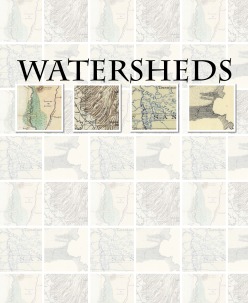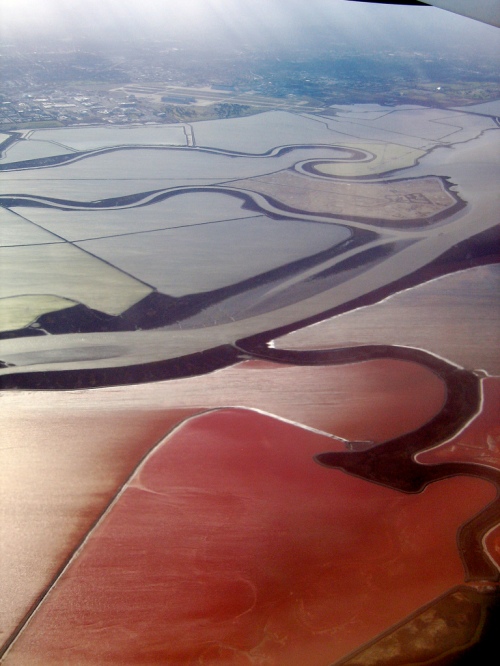Brenda Goeden of BCDC and Ian Wren SF Bay Keepers joined us on August 19th, 2015 at the Exploratorium to to talk about what gets dredged out of the San Francisco Bay.
Most of the dredging that goes on in the bay is for navigation. This is mostly through mud — 80% of the Bay is fine grain mud, and it is dug out to allow deep draft vessels to come through, and keep waters by marina’s clear. The dredging aka mining of sand is mainly for the construction industry – it becomes cement, asphalt, road-base, sub-base and general fill. The grains of sand are grains (.002 to .08 inches in diameter) bigger than mud, and smaller than gravel. it gets mined on demand, not necessarily day in, day out.
There are two main areas whether the sand comes from: Suisun Bay and the Central Bay. Suisun Bay is a finer grain of sand which is often used for back fill in trenches. The coarser sand of the the Central Bay is used for cement. Sand is only found in the high flow areas of the Bay where the water has enough energy to carry the sand. Mud is taken out to the slow wide sides of the Bay.

Sand is important for a number of reasons outside of its commercial uses — it helps build marshes and beach. It provides shoreline protection as it takes more energy to move, it provides a particular kind of habitat, and on the shore provides a place for recreation and having a place for viewing wildlife.
The amount of historical sand, and sand in the Bay is difficult to measure. Most of the sand in the Bay comes from the Delta and the larger watershed (40% of California’s watershed drains into the Bay), and estimated 1.2million cubic yards, with another 300+ thousand cubic yards coming from local streams. Where not blocked, the rivers and creeks, slide and bounce the sand along into the Bay. Storms and other high flow events are key in moving the sand along and into the Bay and beyond.
The sand also is carried out into the ocean, and large dune field lays under water past the Golden Gate Bridge. This was once a wide delta of sand, but has been slowly growing smaller. This changing shape of this sand has affected how sand flows both inside and outside the Bay. The pattern of sand dispersal on Ocean Beach has meant the northern end of the beach has been gaining sand, and the southern has been losing sand leading to fast erosion of the shore. The bay itself is also losing some protection from ocean waves in this process as well. Crissy field on the other hand has benefited, gaining sand from both flows headed out to sea, and sand coming in along the shore.
There’s not a lot known about the habitat underwater in these sands. The Central Bay sand area is the deepest in the Bay 90′-300′ deep where the water is salty, deep, cold, and fast. Aka difficult to study (there has been some studies monitoring what is brought up by the sand miners). We know there are wondrous things going on down there, like the migration of Dungeness crabs — marching in to lay eggs, and then marching out again — but no one has ever seen it or knows the pathways.
Suisun Bay is shallower, warmer, and less salty. The two areas are pretty different, but in both cases these are deserts compared to the meadows of mud. The organisms living there tend to be smaller, efficient, and highly adapted.
Humans have had a huge impact on these fields of sand — the biggest being the pulse of sand brought down from the Sierra’s by gold miners, and estimated 10x the usual flow of sand. Before that, and before many of the rivers and streams were dammed. The flow might have been around 2 million cubic yards. The sand from mining continued to pulse through the system and is only recently pretty much all gone. Now a large portion of the pool of possible erodible materials is trapped behind dams and the delta tunnels.
We still have sand, and we still have sand coming in, but the question now is how much sand do we have, and how much can we afford to take out. Mining has been happening since the 30s, peaking in the years 1949-79. Much of the sand is used locally shipped to different dispersal points around the Bay.
Dredge mud goes to different places, a lot gets shipped and dumped out at sea, or dumped at certain disposal sites in the Bay itself (inside the bay this can disperse contaminants, cause turbidity). These are not the preferable options — that favored option (by BCDC) is helping restoration efforts, filling land that has sunk below sea level on the other side of levees. This is the unfortunately the most expensive option, which there are not a lot of funds for, and small marinas don’t tend to have funds to support that kind of work, and dredging for ports is an expensive enough business that any additional fees would likely be too onerous.
San Francisco Bay Keeper is involved in the issue, hoping to bring in the perspective of the overall health of the Bay and nearby waters, and the sand being an important part of it. The sand taken is not replenished, there is a net loss, and they want to make sure we keep relic sites, and keep mining more in active parts of the flow. They are also looking to insure there is proper compliance and that companies don’t end up taking more than they should. They are looking through commenting on proposals and active litigation to reduce the amount of sand mining going on — to being sand mining to a sustainable level.
On the flip side, if local industries turned to external sources for sand, there may be equally damaging impacts — leaving aside where the sand is being mined from, the carbon costs of shipping that sand by barge or truck would not be small.
The biggest question we seemed all left with was the complicated nature of the question. A unknown or at least unseen, but super valuable resource here in the Bay below us. How much is there? and how much can we afford to take out?
Read Full Post »






